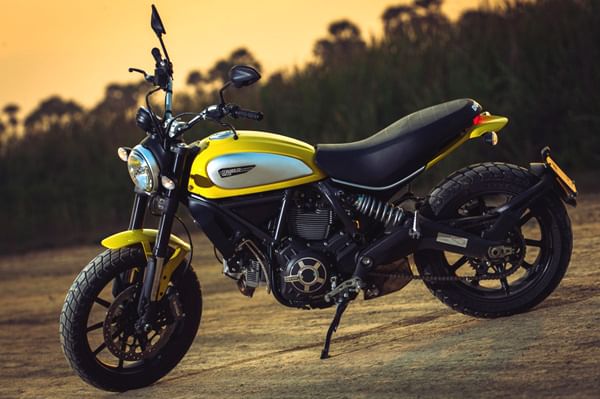Ducati Scrambler review, test ride
Ducati with a difference, the retro Scrambler takes us back to the all important biking basics.
Published on Feb 12, 2015 09:52:00 AM
30,219 Views
Spec-ifically modern
Thankfully, the rose tinted goggles were taken off when choosing the cycle parts. The Scrambler has a neat new trellis frame and a cast alloy swingarm. At the front, there are 41mm USD forks and a preload adjustable side mounted monoshock at the rear. The brakes are Brembos, the front 330mm single disc is grabbed by a four-piston Brembo M4.32B monoblock caliper. The 18-inch front and 17-inch rear rims are wrapped with enduro-derived Pirelli MT60 RS. All this comes backed by ABS from Bosch.
Cutting edge electronics extend to the design too. LED strips lace the circumference of the headlamp and the tail-lamp gets a chunky U-shaped LED element too. The instrument cluster is a single round unit with a LCD display surrounded by tell-tale lights. This unit is small in size but packs in the basics and a bit more. There is a side stand warning icon, speedometer, rev counter, trip and odo, a clock and ambient temperature display too. However, there is no indication of fuel levels or a distance to empty. However, most people are sure to appreciate the underseat USB point to plug in your phone when charge runs low.


Scrambling forward
At the heart of the Scrambler is the Monster 796-derived 803cc L-Twin engine. However, this powerplant has been re-tuned to suit the new, more easy going motorcycle. As a result, power is down to 75bhp and even torque is slightly lower. However, there’s also a newfound stronger bottom-to-mid range power delivery, which makes the Scrambler that much easier to ride in a variety of conditions. The Scrambler is far better suited to the urban grind than the Monster 795, offering better low speed luggability. A pleasantly light action, cable operated clutch made riding the Scrambler that much easier too. While the gearbox, for the most part, was smooth, shifting from 5th into 6th threw up the occasional false neutral on my test bike.
Sure, in true Ducati character, there’s a slight V-twin judder apparent below 2,000rpm, but it clears out quickly enough and starts pulling with gusto. The spread of torque is wide, with a strong pull from as low as 2,000rpm to 8,000rpm. However, as only to be expected, the zing in the Scrambler’s top end a la the 795 is missing. Nonetheless, the versatility of the Scrambler engine more than makes up for it.
Ducati Bikes
Related Videos
Copyright (c) Autocar India. All rights reserved.
Copyright © 2025 Autocar India. All Rights Reserved.


